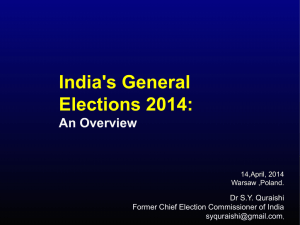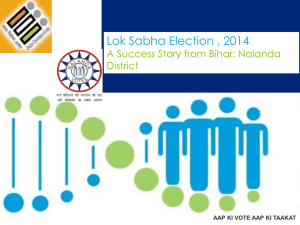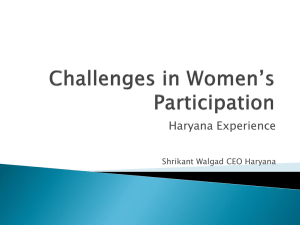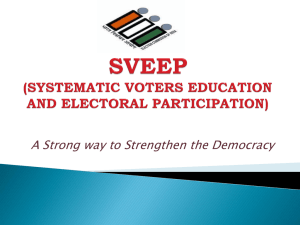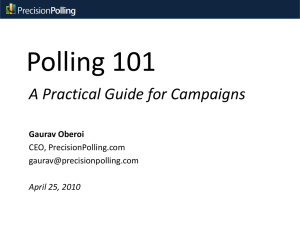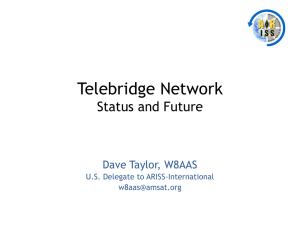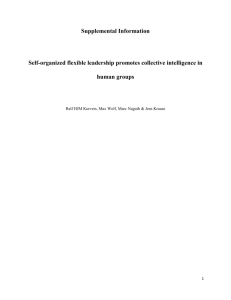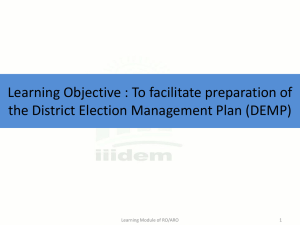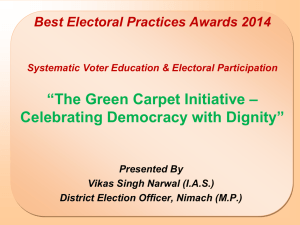Videography - Election Commission of India
advertisement
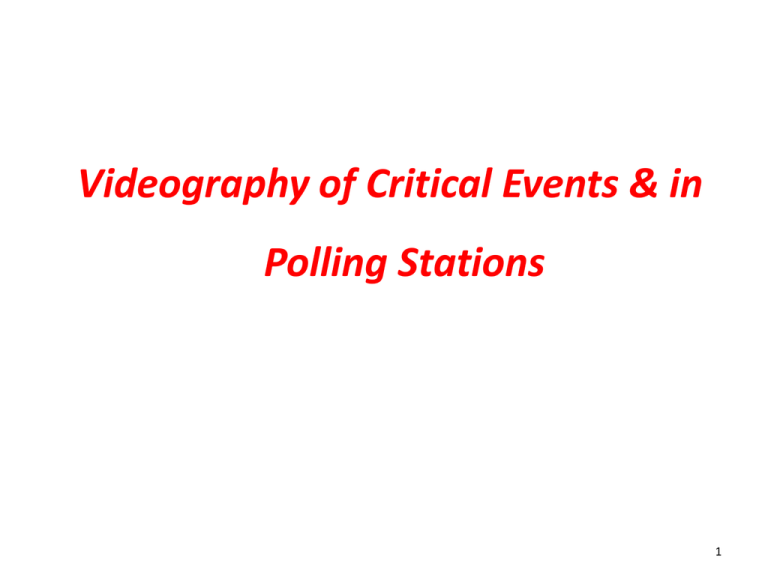
Videography of Critical Events & in Polling Stations 1 Recording through Videography/ Digital Cameras • In order to have a true, faithful and concurrent record of violations of election law and standing instructions of the Commission, RO shall make arrangements to record through videography of critical events during the process of electioneering, incl. but not restricted to the – period of public campaign, • Nomination, Scrutiny, Expenditure monitoring, MCC violations – the day of poll, – the transport and receipt of polled ballot boxes and other materials, – counting of votes and – the declaration of results • in an independent, intelligent and purposeful manner 2 Selection of videographers & their deployment • For this purpose, ROs may make use of video cameras and crew available with the Govtl. or semi-Govtl. agencies within their jurisdiction or hire local private professional videographers – database to be prepared for videographers available • Pvt. videographers to be hired shall be screened thoroughly as to their professional competence, track record, financial viability and other related factors • Videographers should not belong to any political party and should not be known sympathizers or supporters or close relatives of any of the contesting candidates or any of the leaders of any political party or should not have been hired by any political party or contesting candidate 3 Items for special watch and videography Meeting addressed/ attended by Ministers, top national/ State level leaders of recognized parties Riots or riotous situations or commotions brick batting, free-for-all etc.; violent incidents, damaging of property, looting, arson, brandishing of arms etc. Booth capturing Intimidation of voters Inducement/ bribing of voters by distribution of items like saree, dhoti, blankets etc. Canvassing within 100 m. of polling stations Vulgar display of expenditure like huge cutouts etc. 4 Items for special watch and videography.. Movement and activities of candidates with doubtful / criminal records Hypersensitive & sensitive polling stations Important events such as nomination, scrutiny and withdrawal of candidatures Preparation of EVMs by ROs Closure of strong room after deposit of EVMs therein Opening of strong rooms before taking out EVMs for counting Counting process • Note: These are illustrative and not exhaustive. All video and digital photography should be done with date and time recording so that the real time and date can be verified 5 In deference to the suggestions of Supreme Court, contained in its judgment dated 11th January 2005 in Civil Appeal No. 9228 of 2003 – (Janak Baingham Vs. Das Rai and Other) the Commission directs that photography may now be carried inside the polling stations to photograph electors and cover poll proceedings without compromising the secrecy of voting. For such photography, arrangements will be made by the respective District Election Officer (DEO) in consultation with the Chief Electoral Officer. In Particular cases where the Commission has specifically directed video/digital photography of voters in identified areas/assembly segments/polling stations, care should be taken to ensure that faces of all electors coming to cast their vote but not having EPIC of other ECI approved photo identity card, is captured in same sequence as they are entered in form 17-A i.e. Register of Voters. The photograph of electors shall be taken immediately after an entry has been made in form 17-A. Critical events in and around the polling stations should also be captured on video/digital camera in such polling stations. For example. Mock poll and sealing of EVM before commencement of polls Positioning of voting compartment Presence of polling agents Voters waiting outside at the close of scheduled hour of poll and the last voter in queue Visits of sector officers, observers and other electoral functionaries etc. Method of Recording by VST ..1 • At the beginning of shooting, the team will record in voice mode the title and type of event , date, place and the name of the party or the candidate organizing the same. Video Surveillance Team (VST) • It will capture the photo in such a way that the evidence of each vehicle, furniture, rostrum, banner, cutout etc. can be seen clearly and the expense thereon can be estimated, • In relevant cases, statements of the drivers and passengers should also be recorded to prove that the vehicle was used for election purpose 9 Method of Recording by VST ..2 • The video team shall also record in voice describing the estimated number and type of vehicles, chairs/ furniture/ lights/ loudspeakers etc., the approximate size of rostrum/banner/poster/cutout etc. used in the event. . Video Surveillance Team (VST) • They will also record the speech and other events to monitor whether any Model Code of Conduct (MCC) violation has occurred, • Shall prepare a cue sheet at the time of recording in the format and will be given to viewing team along with recorded CD • The video CD should have identification number, date and name of the Staff/officer and should always be kept with the cue sheet. 10 Videography in Expenditure Guidelines • Each Assembly segment would have at least one video surveillance team. Each team will consist of minimum one official and one videographer. Further, videographers are to be there in Flying squads and static surveillance squads also The teams should be properly trained and oriented to capture all MCC relevant events and expenditure related evidences. They should take uninterrupted shot from beginning to end the entire action being taken by the team Both long shots of the scene of action, and close up of incriminating material should be taken The videographer should also record a parallel narration by him on various items he is recording At the start he should record the time, place and nature of investigation/checking being made by the team Car number etc should also be recorded. 11

